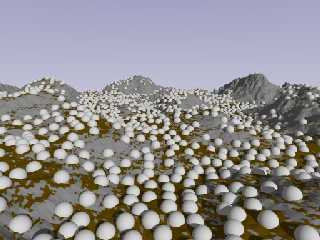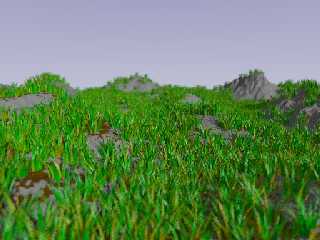 |
 |
|
 |
|
 |
|  |
|  |
|
 |
|
 |
|  |
|  |
|
 |
Hi all!
After a long time of having produced nothing worthwhile to be shown,
I've spent the last few days to sort and implement a set of macros I've
had spinning in my head and experimenting with for a few weeks now.
First a few words to the images: Both use the same heightfields, and
both use the same positions for the grass-patches / spheres. The actual
effect created with the macros is found in the detail:
1. Objects don't intersect (based on radius, not actual object, so
grass-blades
may still intersect)
2. Placement is calculated by checking slope and irregularities of the
nearby vicinity (to avoid placing objects on a tip of an otherwise
unusable field)
The grass-patches are created with some specially written macros,
that make usage of the mesh-modelling-macros I've scripted for
my "Gerberas" image, and are no new invention, just a revisit of a WIP.
What's the purpose of this?
For one, grass never grows in single blades (at least not naturally), so
I
needed to create patches that I would place on a heightfield.
Then, these patches shouldn't overlap too much, which is why the
vegetation-algorithm avoids intersections.
And the slope should be taken into account, as well plateau-checking
(objects
won't be placed where some part would be hanging above a chasm).
Questions, comments, suggestions, criticism, all is welcome.
Please note though that the images are mere tests of the algorithms, and
are only designed to visually please on a secondary basis.
--
Tim Nikias
Homepage: http://www.digitaltwilight.de/no_lights/index.html
Email: Tim### [at] gmx de de
Post a reply to this message
Attachments:
Download 'veg_sph.jpg' (126 KB)
Download 'veg_grs.jpg' (141 KB)
Preview of image 'veg_sph.jpg'

Preview of image 'veg_grs.jpg'

|
 |
|  |
|  |
|
 |
|
 |
|  |
|  |
|
 |
Looks promising.
How many spheres are there and how long did it take to place them all? Are you
using a blockmap?
I like the grass colour, and the effect in the high density regions is good. The
heightfield distorts my perspective somewhat though, because what looks like a
mountain in the background must actually be a small mound (considering the scale
of the grass).
MJL
Post a reply to this message
|
 |
|  |
|  |
|
 |
From: Tim Nikias
Subject: Re: After long absence... Vegetation at Work!
Date: 9 Jul 2002 00:36:02
Message: <3D2A6843.57C4C0A3@gmx.de>
|
|
 |
|  |
|  |
|
 |
> Looks promising.
>
Thank you, that's what I thought too! ;-)
>
> How many spheres are there and how long did it take to place them all? Are you
> using a blockmap?
>
I think there were something around 2600-something spheres, but I
didn't take track of how long it took to generate the places. Not too
long though, a few minutes (under ten). It tried 150 times to add another
50 to the existing ones. While processing, a grid is used (blockmap?), in
which the positions are stored, in order to check only nearby grids for
collisions, not the entire amount of exisiting objects, but in the end,
all positions are saved into a single file, which is then read to place the
spheres/grass-patches (for that I still need to write a macro).
>
> I like the grass colour, and the effect in the high density regions is good. The
> heightfield distorts my perspective somewhat though, because what looks like a
> mountain in the background must actually be a small mound (considering the scale
> of the grass).
>
Thanks, the grass was actually just taken from a similiar image (without
the vegetation algorithm) a few months ago, nothing too funky. Every grass-blade
gets a texture picked from a User-Defined array. Though the amount of
textures are hard-coded (once generated, a blade would always use index
5, for example), I can easily use the grass-patches and some different textures
to vegetate a different climate. Makes it more versatile in use.
Thanks for the comments!
--
Tim Nikias
Homepage: http://www.digitaltwilight.de/no_lights/index.html
Email: Tim### [at] gmx de de
Post a reply to this message
|
 |
|  |
|  |
|
 |
From: Marc Jacquier
Subject: Re: After long absence... Vegetation at Work!
Date: 9 Jul 2002 11:46:26
Message: <3d2b0552@news.povray.org>
|
|
 |
|  |
|  |
|
 |
Hi
I did something similar: check slope & altitude, filter with a bitmap to
avoid chosen zones and grass-patches rather than single blades
http://marc.jacquier.free.fr/Pics/Pen_ar_bed_herb.jpg
Marc
Post a reply to this message
|
 |
|  |
|  |
|
 |
|
 |
|  |
|  |
|
 |
On Mon, 08 Jul 2002 21:23:45 +0200, Tim Nikias <tim### [at] gmx de> wrote:
> Questions, comments, suggestions, criticism, all is welcome.
Looks nice but what is parsing time? Have you compared parsing time with my
solution/advise posted in your thread in povray.general ?
ABX de> wrote:
> Questions, comments, suggestions, criticism, all is welcome.
Looks nice but what is parsing time? Have you compared parsing time with my
solution/advise posted in your thread in povray.general ?
ABX
Post a reply to this message
|
 |
|  |
|  |
|
 |
From: Tim Nikias
Subject: Re: After long absence... Vegetation at Work!
Date: 9 Jul 2002 14:07:04
Message: <3D2B265A.E540117F@gmx.de>
|
|
 |
|  |
|  |
|
 |
Marc Jacquier wrote:
> Hi
> I did something similar: check slope & altitude, filter with a bitmap to
> avoid chosen zones and grass-patches rather than single blades
> http://marc.jacquier.free.fr/Pics/Pen_ar_bed_herb.jpg
> Marc
That bitmap-option is on my to-do-list, along with the combinining
of different sized objects to vegetate a heightfield with different plants,
stones, trees etc.
Did you test for intersections or just randomly placed them in the chosen
zones, where slope & altitude met the requirements?
Care to elaborate a little, I'm really interested!
And the image looks great, though the water and the sky look a little
strange...
--
Tim Nikias
Homepage: http://www.digitaltwilight.de/no_lights/index.html
Email: Tim### [at] gmx de de
Post a reply to this message
|
 |
|  |
|  |
|
 |
From: Tim Nikias
Subject: Re: After long absence... Vegetation at Work!
Date: 9 Jul 2002 14:25:43
Message: <3D2B2AB8.56D25D80@gmx.de>
|
|
 |
|  |
|  |
|
 |
> Looks nice but what is parsing time? Have you compared parsing time with my
> solution/advise posted in your thread in povray.general ?
The function-solution you provided does look very interesting, but as
I am (not yet) that familier with functions, it would be rather difficult
to implement everything the way I want it to behave.
And, thinking about it, I'm not too sure if its just a different approach,
which may be faster, but doesn't provide as much insight. I cannot
check the function to see at which exact positions I placed objects.
I cannot export the function either, which is a drawback. With the
data-storage-system I'm using, I can have a little animation throw
a bunch of objects into the existing bundle very easily, with functions,
I guess I'd have to recalculate for every frame.
So I cannot actually compare the methods, cause I'm not too firm with
functions, and am not able to implement the same behaviour (adding 50
objects per frame). On a single-frame basis, your method might be
better, but not for animations. I can also use some fundamentals of the
systems to cook up a seeding algorithm (place initial seed, grow and
spread out from there), which isn't as easy with the function-system (I
need to keep track of every position created to seed from them).
Parsing time was 7:17 minutes for 2702 positions by trying to add
50 objects 150 times. I'll add a post how long it took to add 50*150
at once... Its not too bad, I guess, and, above all and as mentioned
before, I can access the actual data more easily, which will probably
be essential for some other algorithms I want to implement. Taking
pure placement would make your solution very favourable, I think.
--
Tim Nikias
Homepage: http://www.digitaltwilight.de/no_lights/index.html
Email: Tim### [at] gmx de de
Post a reply to this message
|
 |
|  |
|  |
|
 |
From: Tim Nikias
Subject: Re: After long absence... Vegetation at Work!
Date: 9 Jul 2002 14:44:22
Message: <3D2B2F18.949586E2@gmx.de>
|
|
 |
|  |
|  |
|
 |
...
Similiar time to try placing 50*150 objects (result: 2744) in one go: 7:23
seconds, but objects are placed differently. With every call to the
addition-macro, a
new seed is used (for animations to work, otherwise it would produce the
same random-values all the time), so in one pass does give a slightly different
result than 150 passes...
--
Tim Nikias
Homepage: http://www.digitaltwilight.de/no_lights/index.html
Email: Tim### [at] gmx de de
Post a reply to this message
|
 |
|  |
|  |
|
 |
From: Marc Jacquier
Subject: Re: After long absence... Vegetation at Work!
Date: 9 Jul 2002 17:38:22
Message: <3d2b57ce@news.povray.org>
|
|
 |
|  |
|  |
|
 |
3D2B265A.E540117F@gmx.de...
> Marc Jacquier wrote:
>
> That bitmap-option is on my to-do-list, along with the combinining
> of different sized objects to vegetate a heightfield with different
plants,
> stones, trees etc.
Yes good idea, I thought the same but I didn't finish that work
> Did you test for intersections or just randomly placed them in the chosen
> zones, where slope & altitude met the requirements?
No intersection test I prefered something faster (about 20s parsing for this
image)
> Care to elaborate a little, I'm really interested!
>
> And the image looks great, though the water and the sky look a little
> strange...
I agree It's not my favourite render of this scene but the former didn't
feature grass
Marc
Post a reply to this message
|
 |
|  |
|  |
|
 |
|
 |
|  |
|
 |




![]()